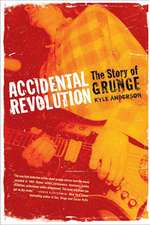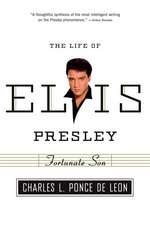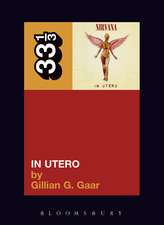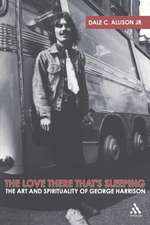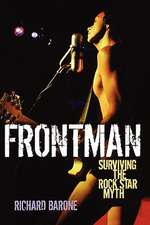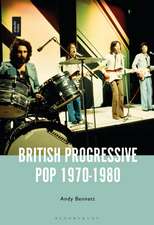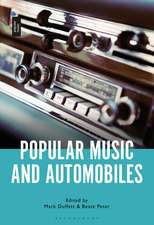I Shot a Man in Reno: A History of Death by Murder, Suicide, Fire, Flood, Drugs, Disease and General Misadventure, as Related in Popular Song
Autor Graeme Thomsonen Limba Engleză Paperback – 14 oct 2008
Ask the gangsta rap devotee. Ask the grizzled blues fanatic and the bearded folk fan. Ask the goth and the indie kid. Ask and they will all tell you the same thing: death and popular music have forever danced hand-in-hand in funereal waltz time. The pop charts and the majority of radio stations' playlists may conspire to convince anyone listening that the world spins on its axis to the tune of "I love you, you love me" and traditional matters of the heart. The rest of us know that we live in a world where red roses will one day become lilies and that death is the motor that drives the greatest and most exhilarating music of all.
"Death music" is not merely a byword for bookish solemnity, or the glorification of murder, drugs and guns. Over the course of the last hundred years it has also been about teenage girls weeping over their high school boyfriend's fatal car wreck; natural disasters sweeping whole communities away; the ever-evolving threat of disease; changing attitudes to old age; exhortations to suicide; the perfect playlist for a funeral; and the thorny question of what happens after the fat lady ceases to sing. Which means that for every "Black Angel's Death Song" there is a "Candle in the Wind," and for every "Cop Killer" there is "The Living Years." Death, like music, is a unifying force. There is something for every taste and inclination, from murderous vengeance to camp sentimentality and everything in between.
Drawing upon original and unique interviews with artists such as Mick Jagger, Richard Thompson, Ice-T, Will Oldham and Neil Finn among many others, I Shot a Man In Reno explores how popular music deals with death, and how it documents the changing reality of what death means as one grows older. It's as transfixing as a train wreck, and you won't be able to put it down. as an epilogue, I Shot A Man In Reno presents the reader with the 40 greatest death songs of all time, complete with a brief rationale for each, acting as a primer for the morbidly curious listener.
"Death music" is not merely a byword for bookish solemnity, or the glorification of murder, drugs and guns. Over the course of the last hundred years it has also been about teenage girls weeping over their high school boyfriend's fatal car wreck; natural disasters sweeping whole communities away; the ever-evolving threat of disease; changing attitudes to old age; exhortations to suicide; the perfect playlist for a funeral; and the thorny question of what happens after the fat lady ceases to sing. Which means that for every "Black Angel's Death Song" there is a "Candle in the Wind," and for every "Cop Killer" there is "The Living Years." Death, like music, is a unifying force. There is something for every taste and inclination, from murderous vengeance to camp sentimentality and everything in between.
Drawing upon original and unique interviews with artists such as Mick Jagger, Richard Thompson, Ice-T, Will Oldham and Neil Finn among many others, I Shot a Man In Reno explores how popular music deals with death, and how it documents the changing reality of what death means as one grows older. It's as transfixing as a train wreck, and you won't be able to put it down. as an epilogue, I Shot A Man In Reno presents the reader with the 40 greatest death songs of all time, complete with a brief rationale for each, acting as a primer for the morbidly curious listener.
Preț: 102.87 lei
Preț vechi: 168.89 lei
-39% Nou
Puncte Express: 154
Preț estimativ în valută:
19.69€ • 20.48$ • 16.25£
19.69€ • 20.48$ • 16.25£
Carte disponibilă
Livrare economică 24 martie-07 aprilie
Preluare comenzi: 021 569.72.76
Specificații
ISBN-13: 9780826428578
ISBN-10: 0826428576
Pagini: 272
Dimensiuni: 138 x 216 x 14 mm
Greutate: 0.3 kg
Editura: Bloomsbury Publishing
Colecția Continuum
Locul publicării:New York, United States
ISBN-10: 0826428576
Pagini: 272
Dimensiuni: 138 x 216 x 14 mm
Greutate: 0.3 kg
Editura: Bloomsbury Publishing
Colecția Continuum
Locul publicării:New York, United States
Caracteristici
Accessible to all musical tastes - from pop to rap, folk, emo and beyond - and a must-have for any music fan.
Cuprins
Introduction
1. Death Ain't Nothin' New: From 'John Barleycorn' to 'John Walker's Blues'
2. Teenage Wildlife: From Sob to Suicide
3. Blood on the Floor: Music, Murder and Morality
4. How Does It Feel?: Death in the Sixties
5. Appetite for Self-Destruction: Oblivion Songs
6. Sweetness Follows?: Into the Great Beyond
7. Gangsta Gangsta: Rap Reclaims the Murder Song
8. Sometimes It Snows in April: The Music of Loss
9. Who Wants to Live Forever?: The Fat Lady's Songbook
10. The Art of Dying (Slight Return)
Epilogue: To Die For
Epilogue: To Die For
The 40 Greatest Death Records
Notes on Sources
Selected Bibliography
Index
Recenzii
Compelling...Divided into chapters covering everything from the common teenage penchant for suicide songs to the evolution of murder ballads and gangsta rap, Thomson displays considerable knowledge of music past and present.
Rock songs...are as much about death as they are about love, argues Greame Thomson in his brilliant I Shot a Man In Reno.
Over the course of this thoughtful essay, Thomson... is a surefooted guide through the musical graveyard. His writing is never dry or academic, but he smartly puts each song into its sociological and psychological context. It's fascinating to see how concepts of death changed over the decades, as Thomson points out trends such as the explosion of death songs during the psychedelic era.... He makes excellent use of quotes from some A-list songwriters; he interviewed Mick Jagger, Paul McCartney, Will Oldham and Nick Cave, and he draws on other sources for remarks from other musicians..... At first, it may seem puzzling that songs on this grim topic have become hits and even popular standards, but Thomson persuasively shows that death very much belongs in pop music.
It's evident from I Shot A Man in Reno that author Graeme Thomson possesses an undying obsession with songs of mortality. To pursue the subject through such terrain as murder ballads, gangsta rap and '50s teen schmaltz, and to make it a topic of conversation with musicians ranging from Ron Sexsmith to Ice-T, one almost has to. ...The book becomes increasingly compelling with each grim avenue it explores.Thomson's well-organized essays provocatively plumb everything from rock n' roll's self-destruction myth to funeral top 10s (really!), but the book is at its strongest when the author supports his own thoughts with those of his interviewees. While the casual, colloquial prose is far from deathless, better musical surveys are hard to find, and the results are positively life affirming.
The long subtitle is a tad inaccurate. This isn't a history; it's a commentary. Damned good one, too, by a journalist who knows his stuff and struts it by spanning recorded death ditties from the English folk song "John Barleycorn," which covers its morbidity by "really" being about growing and preparing the ingredients of beer, to gangsta rap. Refreshingly, he refrains from rock-critic snideness in chapters focused on the teen death songs of the 1950s and 1960s, murder ballads, metaphysical trips to the other side from the high '60s, suicide songs, afterlife musings, gangsta's urban reclamation of the murder song, and mourning songs. He wisely sticks to the genuinely demotic song tradition, ignoring the so-called classic popular songs of Tin Pan Alley and the musical theater (the work of schooled composers), and primarily to the products of that tradition's commercial devolution since the rise of sound recording. Enthralling from the first page, he guarantees rereaders with a penultimate chapter on Europe's top 10 funeral songs and an appendix of his own, an annotated top 40 of death.
[Thomson] moves beyond profile to entertain readers with the long-running and continually fascinating story of deadly mayhem as narrated in song lyrics...his fascination with the lyrics comes with a dry sense of humor, making the subject just as much fun for readers.
it's short and readable though intelligent and erudite.
Through brilliant prose and exhaustive research, [Thomson] presents a potted cultural history which argues that songs about death reveal just as much about how we live... In addition to his own articulate and persuasive thoughts, Thomson's interviews with top table musos such as Paul McCartney, Nick Cave, Richard Thompson and Neil Finn result in one of the most informative and fulfilling music books you're ever likely to read. An essential volume for anyone interested in pop as an all-pervasive social force that soundtracks our lives right up to our last breath.
This is an interesting book, full of lists and little facts that make for some interesting conversations, but it's also thought provoking-you may not always agree with him, but he really knows his stuff and you can't refute that he has a dizzying amount of knowledge of music of every genre to draw upon. There's plenty to keep you reading and thinking.
In the end, death comes to us all. But, the incremental approach of the Grim Reaper through popular song is a phenomenon that has just recently crept into the imaginations of music journalists. I Shot a Man in Reno takes a decidedly academic path toward this subject and the professional distance provides for a smart and scholarly read. It's a tragical history tour of the last hundred-plus years of Western songwriting. From St James Infirmary, around Dead Man's Curve, to the city of Compton, Thomson takes us on a macabre and often hilarious ride. By the time you reach the epilogue of The 40 Greatest Death Records, you'll be ready to discuss the importance of Leader of the Pack and Cop Killer. It's another fine book from Continuum who, along with their 33 1/3 Series, is reshaping the way we read about music.
Positive review on Popmatters.com
The difference between a good movie and a great movie is effort and soul. The Soul of Screenwriting: On Writing, Dramatic Truth, and Knowing Yourself is a guide for improving one's screenplay by infusing the core of the story and its characters with the human voice and enthusiasm that takes a movie into legendary status. Advising against the formulaic writing many screenwriters fall into, The Soul of Screenwriting is motivating and highly recommended reading for any aspiring screenwriter.
Graeme Thomson's book is more than just cornucopia of the splendidly grim and myriad ways we speak of death in rhyming couplets backed with a catchy beat. It's a brain-teasing query into the strange, abstract place death occupies in our culture.
Thomson persuasively shows that death very much belongs in pop music. If music is about the human experience, death must be in there, along with everything else. ...Thomson is a surefooted guide through this musical graveyard. His writing is never dry or academic, but he smartly puts each song into its sociological and psychological context. It's fascinating to see how concepts of death changed over the decades, as Thomson points out trends such as the explosion of death songs during the psychedelic era.
It's evident from I Shot A Man in Reno that author Graeme Thomson possesses an undying obsession with songs of mortality. To pursue the subject through such terrain as murder ballads, gangsta rap and '50s teen schmaltz, and to make it a topic of conversation with musicians ranging from Ron Sexsmith to Ice-T, one almost has to. Though at times it comes off as a magazine think piece that's vastly outgrown its 3,000-word slot, the book becomes increasingly compelling with each grim avenue it explores. Thomson's well-organized essays provocatively plumb everything from rock n' roll's self-destruction myth to funeral top 10s (really!), but the book is at its strongest when the author supports his own thoughts with those of his interviewees. (Richard Thompson almost deserves co-authorship credit for his perceptive contributions.) While the casual, colloquial prose is far from deathless, better musical surveys are hard to find, and the results are positively life affirming.
Intriguing, intelligent analysis...Thomson's real strength is his understated empathy and common sense, most prominent in his excellent chapter on emo.
This is an interesting book, full of lists and little facts that make for some interesting conversations, but it's also thought-provoking... [Thomson] really knows how stuff... There's plenty here to keep you reading and reading.
Mention -Book News, November 2008
Title mention in an article written by the author in The Observer, November 2008
Rock songs...are as much about death as they are about love, argues Greame Thomson in his brilliant I Shot a Man In Reno.
Over the course of this thoughtful essay, Thomson... is a surefooted guide through the musical graveyard. His writing is never dry or academic, but he smartly puts each song into its sociological and psychological context. It's fascinating to see how concepts of death changed over the decades, as Thomson points out trends such as the explosion of death songs during the psychedelic era.... He makes excellent use of quotes from some A-list songwriters; he interviewed Mick Jagger, Paul McCartney, Will Oldham and Nick Cave, and he draws on other sources for remarks from other musicians..... At first, it may seem puzzling that songs on this grim topic have become hits and even popular standards, but Thomson persuasively shows that death very much belongs in pop music.
It's evident from I Shot A Man in Reno that author Graeme Thomson possesses an undying obsession with songs of mortality. To pursue the subject through such terrain as murder ballads, gangsta rap and '50s teen schmaltz, and to make it a topic of conversation with musicians ranging from Ron Sexsmith to Ice-T, one almost has to. ...The book becomes increasingly compelling with each grim avenue it explores.Thomson's well-organized essays provocatively plumb everything from rock n' roll's self-destruction myth to funeral top 10s (really!), but the book is at its strongest when the author supports his own thoughts with those of his interviewees. While the casual, colloquial prose is far from deathless, better musical surveys are hard to find, and the results are positively life affirming.
The long subtitle is a tad inaccurate. This isn't a history; it's a commentary. Damned good one, too, by a journalist who knows his stuff and struts it by spanning recorded death ditties from the English folk song "John Barleycorn," which covers its morbidity by "really" being about growing and preparing the ingredients of beer, to gangsta rap. Refreshingly, he refrains from rock-critic snideness in chapters focused on the teen death songs of the 1950s and 1960s, murder ballads, metaphysical trips to the other side from the high '60s, suicide songs, afterlife musings, gangsta's urban reclamation of the murder song, and mourning songs. He wisely sticks to the genuinely demotic song tradition, ignoring the so-called classic popular songs of Tin Pan Alley and the musical theater (the work of schooled composers), and primarily to the products of that tradition's commercial devolution since the rise of sound recording. Enthralling from the first page, he guarantees rereaders with a penultimate chapter on Europe's top 10 funeral songs and an appendix of his own, an annotated top 40 of death.
[Thomson] moves beyond profile to entertain readers with the long-running and continually fascinating story of deadly mayhem as narrated in song lyrics...his fascination with the lyrics comes with a dry sense of humor, making the subject just as much fun for readers.
it's short and readable though intelligent and erudite.
Through brilliant prose and exhaustive research, [Thomson] presents a potted cultural history which argues that songs about death reveal just as much about how we live... In addition to his own articulate and persuasive thoughts, Thomson's interviews with top table musos such as Paul McCartney, Nick Cave, Richard Thompson and Neil Finn result in one of the most informative and fulfilling music books you're ever likely to read. An essential volume for anyone interested in pop as an all-pervasive social force that soundtracks our lives right up to our last breath.
This is an interesting book, full of lists and little facts that make for some interesting conversations, but it's also thought provoking-you may not always agree with him, but he really knows his stuff and you can't refute that he has a dizzying amount of knowledge of music of every genre to draw upon. There's plenty to keep you reading and thinking.
In the end, death comes to us all. But, the incremental approach of the Grim Reaper through popular song is a phenomenon that has just recently crept into the imaginations of music journalists. I Shot a Man in Reno takes a decidedly academic path toward this subject and the professional distance provides for a smart and scholarly read. It's a tragical history tour of the last hundred-plus years of Western songwriting. From St James Infirmary, around Dead Man's Curve, to the city of Compton, Thomson takes us on a macabre and often hilarious ride. By the time you reach the epilogue of The 40 Greatest Death Records, you'll be ready to discuss the importance of Leader of the Pack and Cop Killer. It's another fine book from Continuum who, along with their 33 1/3 Series, is reshaping the way we read about music.
Positive review on Popmatters.com
The difference between a good movie and a great movie is effort and soul. The Soul of Screenwriting: On Writing, Dramatic Truth, and Knowing Yourself is a guide for improving one's screenplay by infusing the core of the story and its characters with the human voice and enthusiasm that takes a movie into legendary status. Advising against the formulaic writing many screenwriters fall into, The Soul of Screenwriting is motivating and highly recommended reading for any aspiring screenwriter.
Graeme Thomson's book is more than just cornucopia of the splendidly grim and myriad ways we speak of death in rhyming couplets backed with a catchy beat. It's a brain-teasing query into the strange, abstract place death occupies in our culture.
Thomson persuasively shows that death very much belongs in pop music. If music is about the human experience, death must be in there, along with everything else. ...Thomson is a surefooted guide through this musical graveyard. His writing is never dry or academic, but he smartly puts each song into its sociological and psychological context. It's fascinating to see how concepts of death changed over the decades, as Thomson points out trends such as the explosion of death songs during the psychedelic era.
It's evident from I Shot A Man in Reno that author Graeme Thomson possesses an undying obsession with songs of mortality. To pursue the subject through such terrain as murder ballads, gangsta rap and '50s teen schmaltz, and to make it a topic of conversation with musicians ranging from Ron Sexsmith to Ice-T, one almost has to. Though at times it comes off as a magazine think piece that's vastly outgrown its 3,000-word slot, the book becomes increasingly compelling with each grim avenue it explores. Thomson's well-organized essays provocatively plumb everything from rock n' roll's self-destruction myth to funeral top 10s (really!), but the book is at its strongest when the author supports his own thoughts with those of his interviewees. (Richard Thompson almost deserves co-authorship credit for his perceptive contributions.) While the casual, colloquial prose is far from deathless, better musical surveys are hard to find, and the results are positively life affirming.
Intriguing, intelligent analysis...Thomson's real strength is his understated empathy and common sense, most prominent in his excellent chapter on emo.
This is an interesting book, full of lists and little facts that make for some interesting conversations, but it's also thought-provoking... [Thomson] really knows how stuff... There's plenty here to keep you reading and reading.
Mention -Book News, November 2008
Title mention in an article written by the author in The Observer, November 2008

